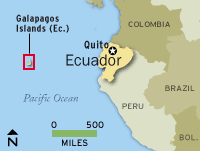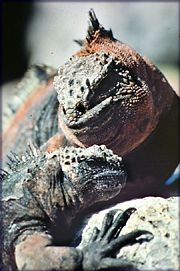
Melissa
Kaplan's
Herp Care Collection
Last updated
January 1, 2014
The Amazin' Shrinkin' Iguana
To survive El Niño, lizards become smaller
Kenneth Chang, ABCNews.com, 2000
|
One of the larger iguanas, Amblyrhynchus cristatus is the only iguana that depends on a marine environment, diving for algae. This one is roughly one foot long from snout to anus. (Martin Wikelski/University of Illinois) |
Jan. 5 — When at least one species of iguana goes hungry, it doesn’t just become skinny. It gets shorter, too. Much to his surprise, a biologist has found that in times of El Niño-induced famine, iguanas in the Galápagos Islands shrink in length then regrow when food becomes plentiful again. The finding, reported in this week’s issue of the journal Nature, is the first of a shrinking adult vertebrate animal. The Ruler
Isn’t Lying Previously, when biologists found data indicating a shrinking animal, they generally fudged the growth rate to zero. |
|
Temperatures in waters around the Galápagos Islands, located off Ecuador, rise considerably during El Niño years, changing the ecological balance. ABCNEWS.com/Magellan Geographix) |
“For vertebrates, it’s sort of a dogma [that they don’t shrink],” says Wikelski, who says he believes closer observations will reveal other shrinking animals. Since 1987, Wikelski, a professor at of ecology, ethology and evolution at University of Illinois at Urbana-Champaign, has been flipping over Galápagos marine iguanas, stretching them out on their backs and measuring their snout-to-anus length. By branding the iguanas, Wikelski tracks individuals through many years. On one island, iguanas grew up to 16 inches long — not including their tails — and 7½ pounds. When the warm waters of the 1997-98 El Niño arrived, the red and green algae the iguanas eat disappeared. In those two years, some of the iguanas shed more than one-third of their weight — and shrank in length by up to 20 percent. |
|
A male and female pair of Galápagos marine iguanas. (Martin Wikelski/University of Illinois) |
That’s the equivalent of a hungry Shaquille O’Neal dwindling from 7 foot 1 to 5 foot 8. Digesting
One’s Own Skeleton That’s also too much to be explained by the shrinking of just cartilage and connective tissue. Wikelski hypothesizes the iguanas literally digest part of their bones. “We’re not entirely sure about the mechanism yet,” he says. The miniaturized iguanas forage more efficiently, Wikelski says, and the smaller size also allows the cold-blooded lizards to be warmed more easily by the sun. “The animals that are most prone to starvation are the large animals,” he says. When El Niño goes away and the algae return, the iguanas grow again. In times when food is bountiful, being the big lizard on the island is an advantage. |
“They fight for territories,” Wikelski says. “Those that are largest get those territories more easily. It’s a reproductive advantage. You want to be the largest one during the non-El Niño years, and then you want to be the smallest one during the El Niño years.”
To help puzzle out how the iguanas do their shrinking trick, Wikelski will bring along a portable X-ray machine during his next trip to the Galápagos Islands.
And if the iguanas look any bigger or smaller than the last time he saw them, he’ll know it isn’t just an illusion.
Martin Wikelski is now teaching at Princeton. Check his website for information on current projects and publications.
For more information on Galápagos iguanas
Iguanas shrink to survive on less food resulting from weather change - UIUC Press Release
Diving Dragons of the Galápagos - Martin Wikelski
The Galápagos Marine Iguana:.a model system for the evolution of body size - Martin Wikelski
Marine Iguanas - Cornell University
Oil Spill Starves Iguanas: Ecologist Sues
Marine
iguanas: The first known animals with backbones that grow shorter when
food is scarce
This article from WorldBookOnline has links to lots of related information
- great site for students researching material for school projects.


